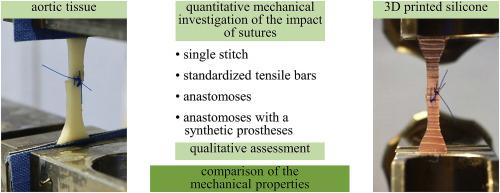Journal of the Mechanical Behavior of Biomedical Materials ( IF 3.3 ) Pub Date : 2020-08-25 , DOI: 10.1016/j.jmbbm.2020.104033 Hannah Riedle 1 , Ryan Chaban 2 , Ahmed Ghazy 2 , Charlotte Piplat 1 , Bernhard Dorweiler 3 , Jörg Franke 1

|
The imitation of biological tissue in a synthetic physical model can benefit many medical applications, e.g. pre surgical planning or education. For a quantitative validation of the model's mechanical behavior, standardized testing on both, the biological original and the artificial material, is necessary. In four parts, this study focuses on the biomechanical analysis of the impact of sutures for aortic modelling using 3D printed silicone. Testing methods are developed and executed on biological and synthetic samples. The first part is the determination of the pullout strength of a single stitch. The second part is the investigation of the reduction of the tensile strength and elongation of tensile bars due to stitching. Third, the tensile testing of biological and artificial vessels repaired with an anastomosis gives information about the transferability to real surgical applications. A qualitative feedback study with surgical experts concludes the evaluation.
The study reveals that the pullout strength is independent from the fiber or notch direction, but that repaired aortic tensile bars show a dependency on the fiber direction of the tissue. Additionally, the circular seam of the anastomosis provides a more stable connection than multiple single stitches. For the artificial models, the mechanical behavior mainly depends on the mechanical properties of the base silicone, here represented by the Shore A hardness, rather than the manufacturing process. When compared to the biological original the most similar material varies depending on the mechanical property in focus.
中文翻译:

与3D打印的有机硅建模材料相比,主动脉组织缝合行为的实验确定。
在合成物理模型中模仿生物组织可以使许多医学应用受益,例如手术前的计划或教育。为了对模型的机械行为进行定量验证,必须对生物原始材料和人造材料进行标准化测试。这项研究分为四个部分,重点是对使用3D打印硅树脂进行缝合对主动脉建模的影响进行生物力学分析。对生物和合成样品开发并执行了测试方法。第一部分是确定单针的抗拉强度。第二部分是对由于缝合导致的抗拉强度和伸长率降低的研究。第三,经吻合修复的生物和人造血管的拉伸测试可提供有关可移植到实际外科手术应用的信息。与外科专家进行的定性反馈研究总结了评估结果。
研究表明,拔出强度与纤维或切口方向无关,但是修复的主动脉拉伸棒显示出对组织纤维方向的依赖性。另外,与多个单针相比,吻合术的圆形接缝提供了更稳定的连接。对于人造模型,机械性能主要取决于基础有机硅的机械性能(此处以肖氏A硬度表示),而不是制造过程。与生物学原件相比,最相似的材料会根据聚焦的机械性能而变化。











































 京公网安备 11010802027423号
京公网安备 11010802027423号